Key takeaways:
- Interior landscaping enhances both aesthetics and wellbeing by bringing nature indoors, fostering a peaceful and productive environment.
- Gardening at home cultivates patience, resilience, and a deeper connection to nature, transforming routine tasks into joyful experiences.
- Effective indoor gardening techniques, such as grow lights and companion planting, can significantly improve plant care and overall indoor ambiance.
- Lessons learned from nurturing plants outdoors can be applied indoors, emphasizing the importance of adaptability, care, and creating a harmonious living space.
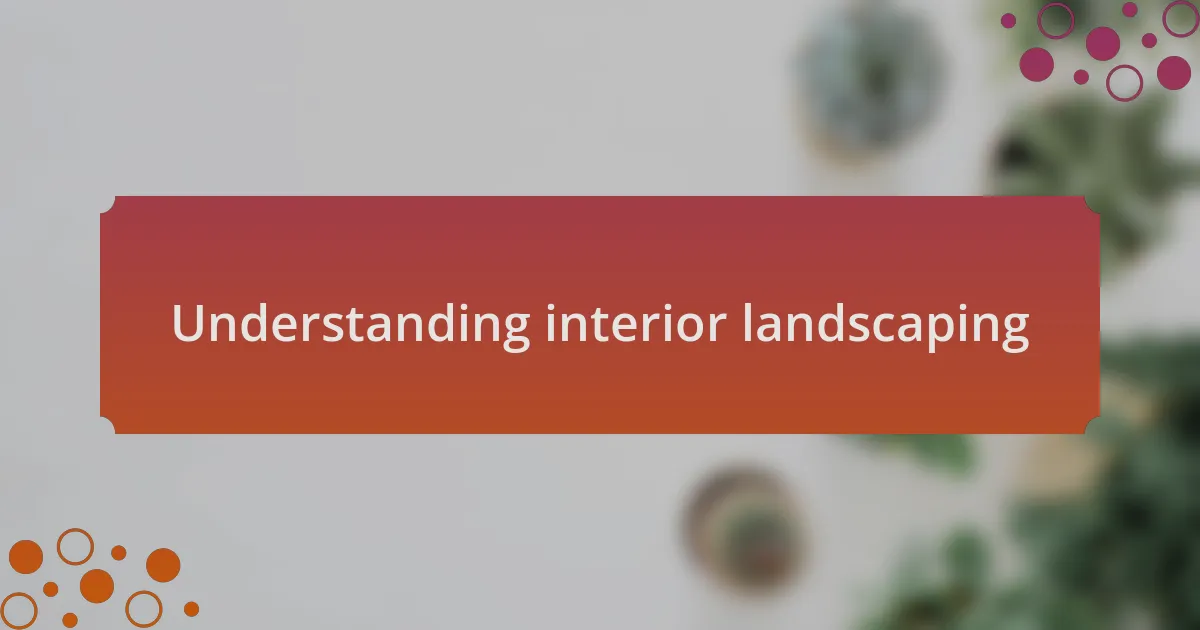
Understanding interior landscaping
Interior landscaping is all about bringing the beauty of nature indoors. I remember the first time I added plants to my living space; it felt like a breath of fresh air transformed my home. I often wonder how a simple pot of greenery can uplift not just a room but also my mood.
When I think about interior landscaping, I realize it’s more than just aesthetics; it’s about creating a harmonious environment that nurtures wellbeing. A few years back, I decided to place a large, leafy fiddle leaf fig tree in the corner of my office. That tree became more than just decor; it became a silent companion during my long work hours, reminding me of the outdoor serenity I often craved.
Can you imagine working in a place where the walls feel alive? The sounds of nature—like the rustle of leaves—can make even the busiest areas feel calm and inviting. Adding plants isn’t just for looks; it’s a simple way to foster a peaceful atmosphere that encourages productivity and creativity. In my experience, the transformation in my workspace has been astonishing, showing just how powerful greenery can be in an interior setting.
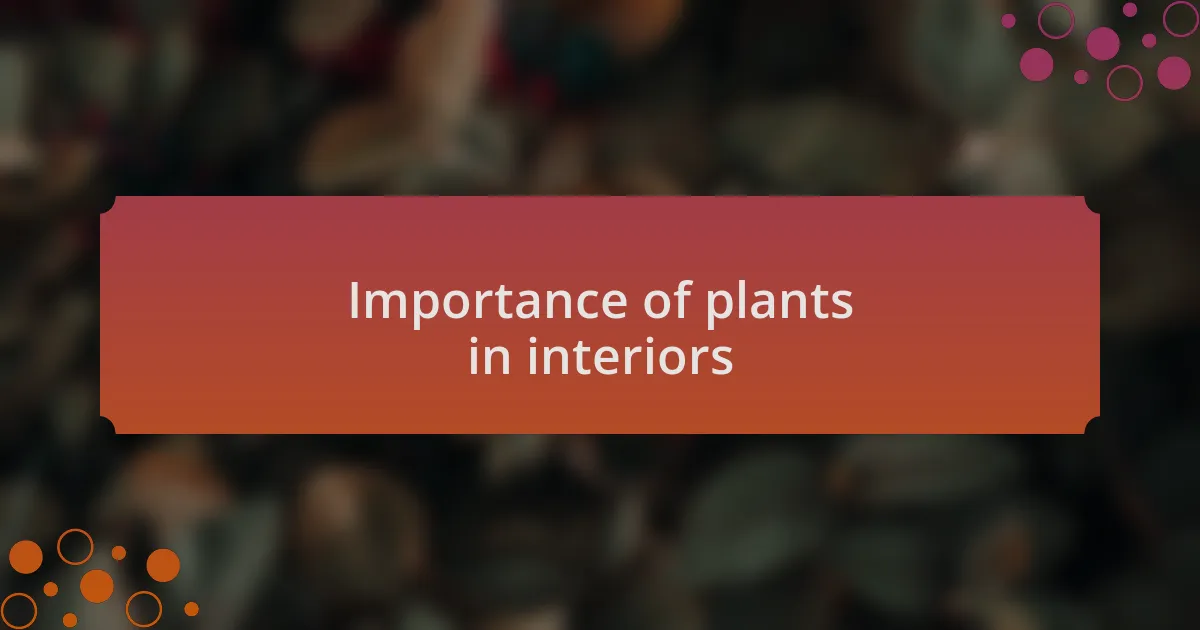
Importance of plants in interiors
Plants in interiors play a crucial role beyond mere decoration; they enhance the air quality and bring a sense of vitality to any space. I still remember when I added a few small succulents to my kitchen windowsill. Not only did they improve the ambiance, but they also seemed to purify the air, making mornings feel fresher as I brewed my coffee. It’s impressive how a living element can elevate our daily routines.
Including greenery indoors can significantly impact our mental and emotional wellbeing. I was surprised to find that simply tending to my desk plant provided a meditative break in my busy day. There’s something soothing about nurturing life, a reminder of our connection to nature even amidst concrete surroundings. Have you ever noticed how your mood shifts after watering your plants? It’s these small interactions that remind us to pause and appreciate the here and now.
Moreover, plants create visual interest and harmony, transforming a lifeless corner into a vibrant space full of personality. I once rearranged my living room by placing a tall snake plant beside my bookshelf, and it felt like the room suddenly became alive with energy. The textures and colors of the leaves provided a beautiful contrast to the static elements around them. Isn’t it fascinating how a single plant can change our perception of a space? It encourages us to engage more actively with our interiors, truly making them our own.
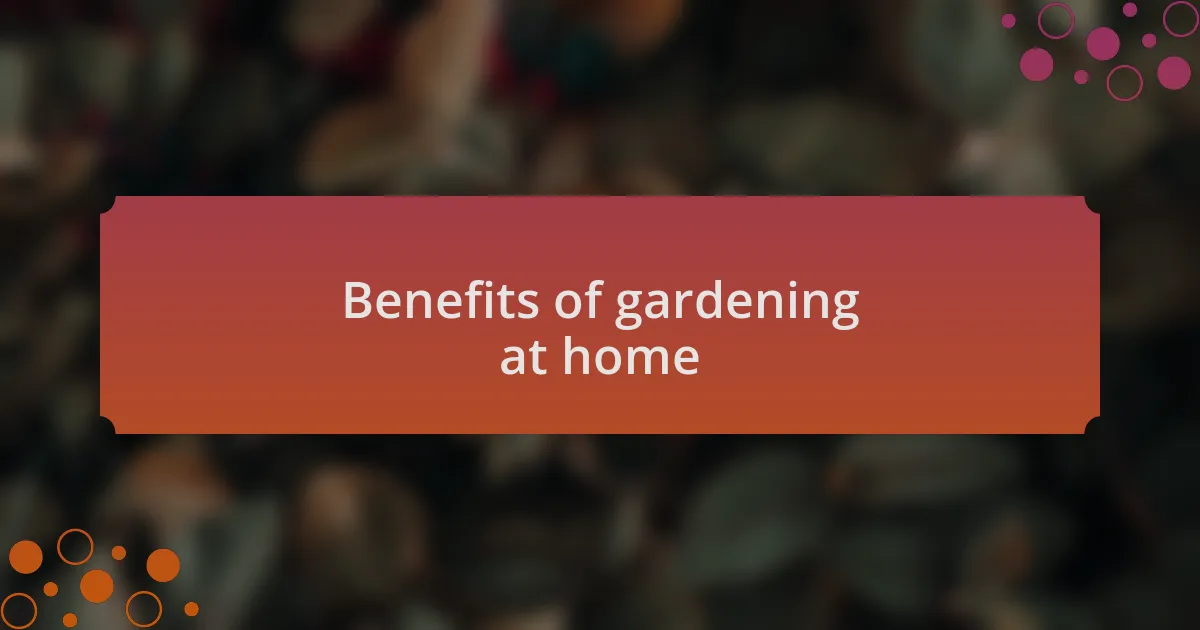
Benefits of gardening at home
Gardening at home offers a wonderful opportunity to cultivate not just plants, but also patience and perseverance. When I first attempted to grow my own vegetables, I faced failure with wilted leaves and pests. Each setback taught me about resilience and the joy of nurturing something from seed to harvest. Have you ever found satisfaction in overcoming obstacles, even in what seems like a simple task?
Beyond mental benefits, home gardening serves as a tangible connection to the food we consume. The first time I tasted a tomato I grew myself, I was amazed at the burst of flavor compared to store-bought ones. This experience was eye-opening; it felt like I had crafted something special with my own hands. It made me appreciate the effort involved in bringing food to the table. Isn’t it empowering to know that with just some dirt and seeds, you can produce nourishing food?
Furthermore, gardening introduces a sense of routine and structure, which is especially valuable in our busy lives. I found that spending time in my garden became a beloved ritual, marking time in my week. Every Sunday morning, I would step outside, coffee in hand, and check on my plants. This simple act of care provided a grounding moment amidst the chaos. Isn’t there a certain peace that comes from immersing ourselves in a hobby that reconnects us with our natural instincts?
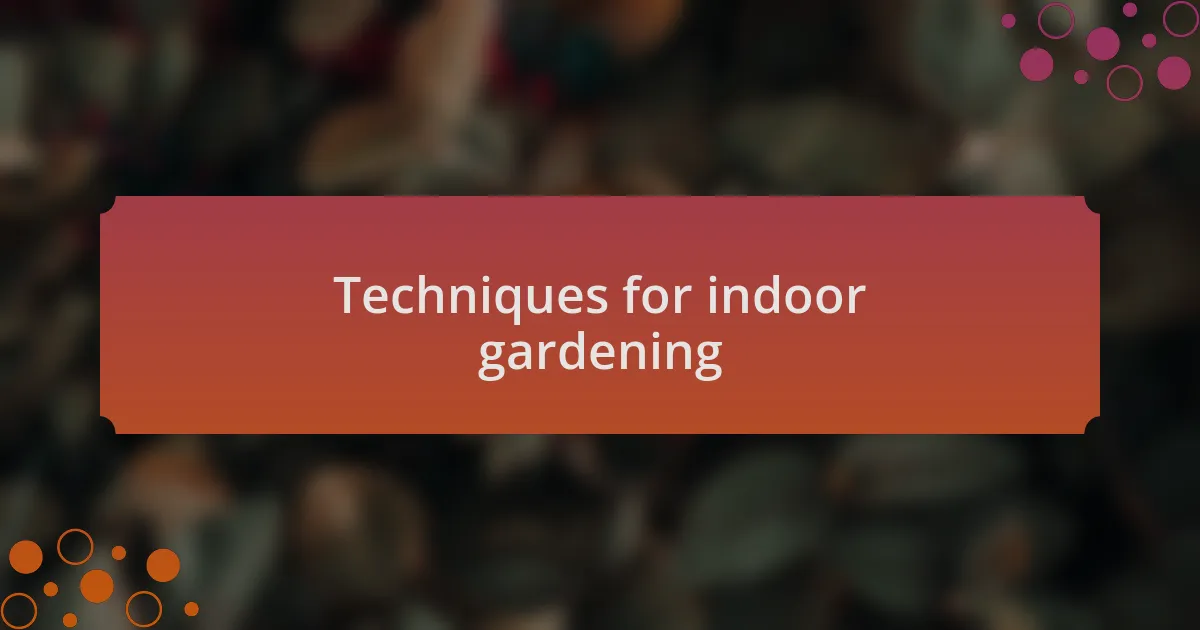
Techniques for indoor gardening
When it comes to indoor gardening, one technique I’ve found incredibly effective is using a combination of grow lights and natural sunlight. I recall the first time I set up a grow light for my herbs; it was exhilarating to see them thrive in conditions I had created. This approach not only maximizes growth but also allows for year-round gardening, regardless of the weather outside. Have you ever wondered how artificial light can mimic the sun’s nurturing rays?
Another technique I highly recommend is employing self-watering pots, which have made a significant difference in my plant-care routine. I remember a busy week when I was worried about my newly potted succulents; these clever pots allowed me to enjoy my plants without constant attention. They regulate moisture levels automatically, reducing the risk of over- or under-watering, which I know can be a common concern. Isn’t it comforting to have a system that supports your green thumb?
Additionally, I discovered the power of companion planting even in my indoor space. By placing herbs like basil near my tomato plants, I noticed that not only did they thrive, but their flavors enhanced each other. I can still feel the excitement of harvesting them together for a fresh pasta dish. Have you ever considered how the relationship between plants can elevate your gardening experience?
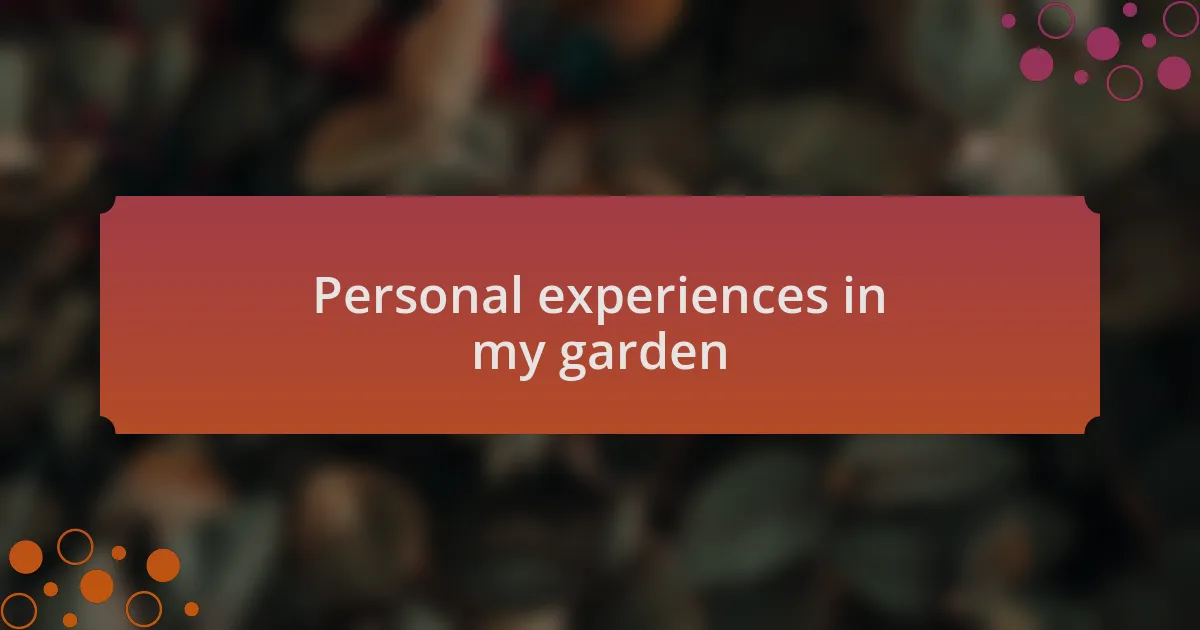
Personal experiences in my garden
As I delved deeper into gardening, I became fascinated by the little surprises that nature unveiled. I vividly remember the day I noticed a tiny ladybug crawling on one of my houseplants; it felt like the garden was sharing a secret with me. How often do we overlook these small wonders that remind us of the beauty surrounding us?
I also learned that patience is a gardener’s greatest virtue. There was a time when I impulsively trimmed my beloved snake plant, desperate for it to grow faster. Instead of flourishing, it seemed to sulk for weeks. Reflecting on that experience taught me that nurturing plants requires a gentle approach, and sometimes, allowing them to grow at their own pace is indeed the best course of action.
Another memorable moment in my garden came unexpectedly during a late afternoon watering session. The scent of fresh soil mingling with my blooming geraniums filled the air, transporting me to a serene space of gratitude. Have you ever stopped to appreciate how gardening can evoke such powerful emotions? It’s these moments that turn mundane chores into joyous rituals, deepening my connection to nature.
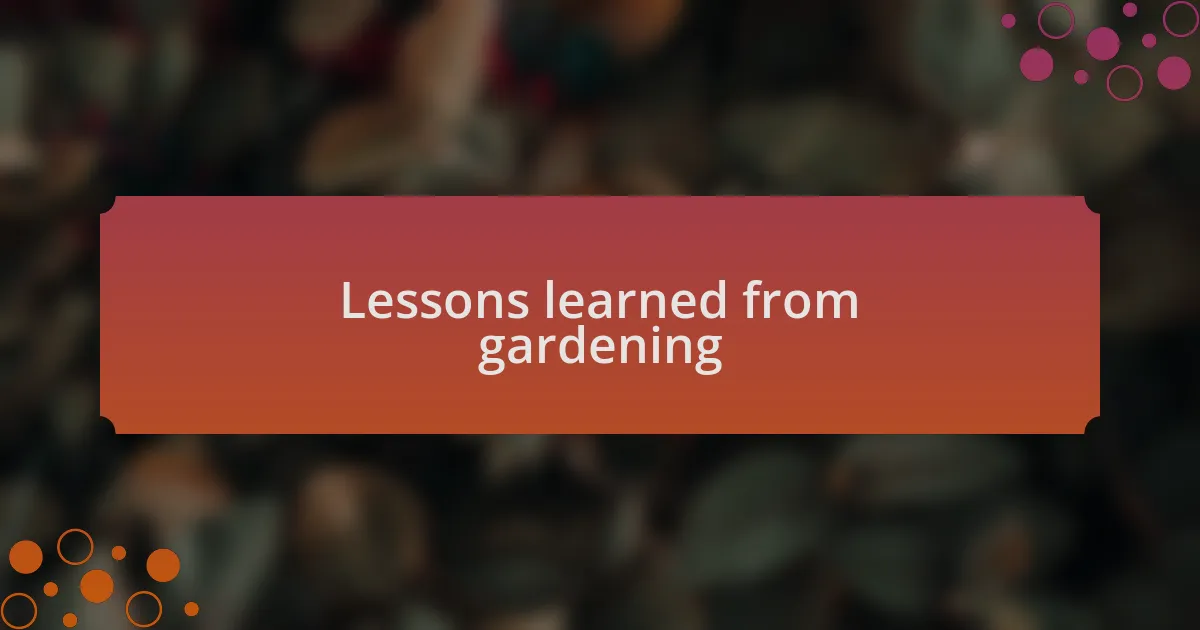
Lessons learned from gardening
Tending to my garden has taught me the significance of observation. One evening, while checking on my ferns, I noticed that one was thriving in the corner, basking in the filtered sunlight. That simple realization reminded me how vital it is to be aware of our surroundings and adapt to the needs of our plants, just as we should in our lives.
I remember a rainy day when I decided to embrace the weather and work in the garden. As I dug my hands into the damp earth, I found myself feeling grounded, almost meditative. It struck me that sometimes, embracing discomfort can lead to unexpected growth, both for our plants and ourselves. Have you ever considered how challenges in gardening mirror those we face in daily life?
One of the most profound lessons came when I planted my first herb garden. I started with basil and was amazed by how quickly it flourished with just a bit of sunlight and water. This experience reinforced the idea that nurturing relationships, much like nurturing plants, requires consistent effort and care. Are we truly taking the time to nurture the important aspects of our lives, just as we do our gardens?
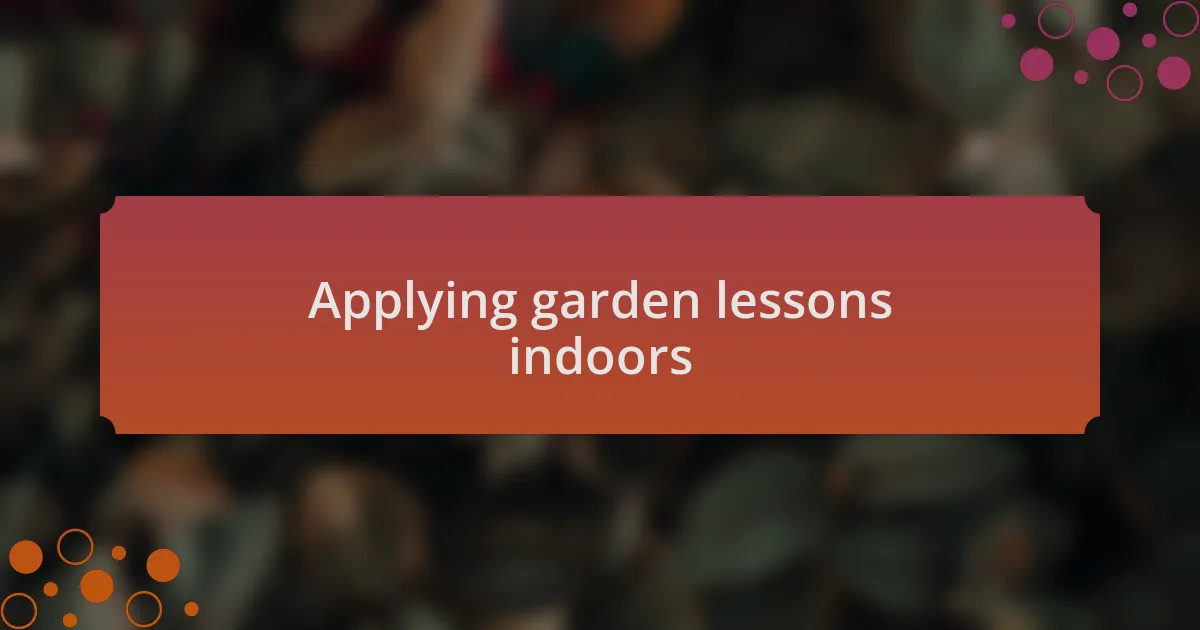
Applying garden lessons indoors
Creating an indoor garden has allowed me to apply everything I’ve learned from my outdoor experiences. For instance, I often find myself gravitating towards plants that require similar care to my favorites outside. I remember when I brought a peace lily indoors; the way it responded to the consistent moisture in the air reminded me of the tender attention I gave my outdoor blooms. This connection between care and growth is universal. How intentional are we with our indoor plants, just as we are outdoors?
I’ve also discovered that the concept of rotation goes beyond gardening. As I shift my potted plants to catch the changing light throughout the seasons, I see parallels in my own life. Just as plants need to adapt to their environment, I realized that I too should be flexible in my routines and habits. I think, isn’t it interesting how embracing change can enhance our indoor spaces and our personal growth?
When I embraced the idea of companion planting, it transformed my approach indoors. I began grouping my succulents with a small fern, noticing how the interaction between different plants can create a more vibrant environment. This experience led me to ponder: how can combining different elements in our living spaces enhance our overall well-being? My indoor plants have become a source of inspiration, reminding me daily of the balance we can maintain in our environment and our lives.